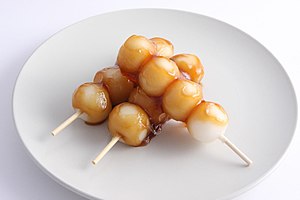
Mochi is a Japanese rice cake made of mochigome (もち米), a short-grain japonica glutinous rice, and sometimes other ingredients such as water, sugar, and cornstarch. The steamed rice is pounded into paste and molded into the desired shape. In Japan, it is traditionally made in a ceremony called mochitsuki. While eaten year-round, mochi is a traditional food for the Japanese New Year, and is commonly sold and eaten during that time.

Anmitsu is a wagashi that dates to the Meiji era.

Hanabiramochi (葩餅) is a Japanese sweet (wagashi), usually eaten at the beginning of the year. Hanabiramochi are also served at the first tea ceremony of the new year.

Wagashi is traditional Japanese Confectionery, typically made using plant-based ingredients and with an emphasis on seasonality. Wagashi generally makes use of cooking methods that pre-date Western influence in Japan. It is often served with green tea.

Tsukune (つくね、捏、捏ね) is a Japanese chicken meatball most often cooked yakitori style and sometimes covered in a sweet soy or yakitori tare, which is often mistaken for teriyaki sauce.

Tsukimi or Otsukimi (お月見), meaning, "moon-viewing", are Japanese festivals honoring the autumn moon, a variant of the Mid-Autumn Festival. The celebration of the full moon typically takes place on the 15th day of the eighth month of the traditional Japanese calendar, known as Jūgoya; the waxing moon is celebrated on the 13th day of the ninth month, known as Jūsan'ya. These days normally fall in September and October of the modern solar calendar.

Manjū is a traditional Japanese confection, usually a small, dense bun with a sweet filling. They come in many shapes and varieties.

Kinako is roasted soybean flour, used in Japanese cuisine. In English, it is usually called "roasted soy flour". Kinako is mostly used as a topping to flavor rice cakes like mochi.
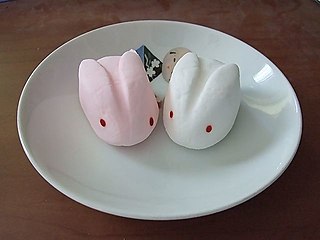
Miyagegashi refers to a sweet made with the purpose of selling it as a souvenir. As with most other Japanese souvenirs, the typical miyagegashi is a regional specialty and cannot be bought outside its specific geographic area. The making and selling of omiyagegashi is an important part of Japan's souvenir industry.

Sakuramochi is a Japanese confection (wagashi) consisting of sweet, pink-colored rice cake (mochi) with red bean paste (anko) filling, wrapped in a pickled cherry blossom (sakura) leaf, which may or may not be eaten depending on individual preference.
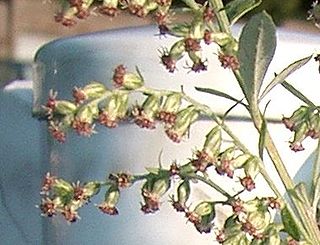
Artemisia princeps, also commonly called yomogi, Japanese mugwort, Korean wormwood, Korean mugwort or wormwood in English, is an Asian plant species in the sunflower family, native to China, Japan and Korea. It is a perennial, very vigorous plant that grows to 1.2 meters. This species spreads rapidly by means of underground stolons and can become invasive. It bears small, buff-colored flowers from July to November which are hermaphroditic, and pollinated by wind. The leaves are feather shaped, scalloped and light green, with white dense fuzz on the underside.
A Kibi dango is a type of wagashi sweet or snack with an eponymous reference to Kibi-no-kuni, an old province roughly coincident with today's Okayama Prefecture. It is made by forming gyūhi, a sort of soft mochi, into flat round cakes. Glutinous rice, starch, syrup and sugar are the basic ingredients. It is manufactured by some fifteen confectioners based in Okayama City. While perhaps originally made from kibi, the modern recipe uses little or no millet, and substantively differs from kibi dango of yore, famous from the Japanese heroic folk tale of Momotarō or "Peach Boy"; nevertheless, "Kibi dango" continues to be represented as being the same as the folk hero Peach Boy's dumpling.
Kibi dango is Japanese dumpling made from the meal or flour of the kibi grain. The treat was used by folktale-hero Momotarō to recruit his three beastly retainers, in the commonly known version of the tale.

Kashiwa mochi is a wagashi of white mochi surrounding a sweet anko filling with a kashiwa (oak) leaf wrapped around it. Unlike the cherry blossom leaf used in sakura mochi, the oak (kashiwa) leaf used in kashiwa mochi is not eaten and used only to symbolize the prosperity of one's descendants.
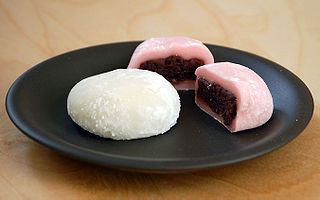
Daifukumochi (大福餅), or daifuku (大福), is a wagashi, a type of Japanese confection, consisting of a small round mochi stuffed with a sweet filling, most commonly anko, a sweetened red bean paste made from azuki beans. Daifuku is a popular wagashi in Japan and is often served with green tea.
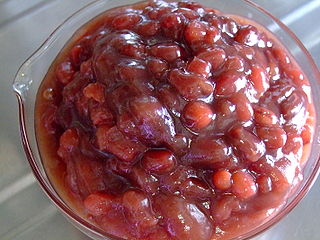
Red bean paste or red bean jam, also called adzuki bean paste or anko, is a paste made of red beans, used in East Asian cuisine. The paste is prepared by boiling the beans, then mashing or grinding them. At this stage, the paste can be sweetened or left as it is. The color of the paste is usually dark red, which comes from the husk of the beans. In Korean cuisine, the adzuki beans can also be husked prior to cooking, resulting in a white paste. It is also possible to remove the husk by sieving after cooking, but before sweetening, resulting in a red paste that is smoother and more homogeneous.
